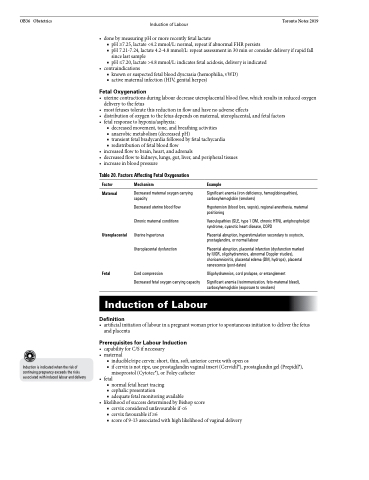Page 876 - TNFlipTest
P. 876
OB36 Obstetrics
Induction of Labour Toronto Notes 2019
• donebymeasuringpHormorerecentlyfetallactate
■ pH ≥7.25, lactate <4.2 mmol/L: normal, repeat if abnormal FHR persists
■ pH 7.21-7.24, lactate 4.2-4.8 mmol/L: repeat assessment in 30 min or consider delivery if rapid fall
since last sample
■ pH ≤7.20, lactate >4.8 mmol/L: indicates fetal acidosis, delivery is indicated
• contraindications
■ known or suspected fetal blood dyscrasia (hemophilia, vWD) ■ active maternal infection (HIV, genital herpes)
Fetal Oxygenation
• uterinecontractionsduringlabourdecreaseuteroplacentalbloodflow,whichresultsinreducedoxygen delivery to the fetus
• mostfetusestoleratethisreductioninflowandhavenoadverseeffects
• distributionofoxygentothefetusdependsonmaternal,uteroplacental,andfetalfactors
• fetalresponsetohypoxia/asphyxia:
■ decreased movement, tone, and breathing activities
■ anaerobicmetabolism(decreasedpH)
■ transient fetal bradycardia followed by fetal tachycardia ■ redistribution of fetal blood flow
• increasedflowtobrain,heart,andadrenals
• decreasedflowtokidneys,lungs,gut,liver,andperipheraltissues
• increaseinbloodpressure
Table 20. Factors Affecting Fetal Oxygenation
Factor
Maternal
Uteroplacental
Fetal
Mechanism
Decreased maternal oxygen carrying capacity
Decreased uterine blood flow Chronic maternal conditions Uterine hypertonus Uteroplacental dysfunction
Cord compression
Decreased fetal oxygen carrying capacity
Example
Significant anemia (iron deficiency, hemoglobinopathies), carboxyhemoglobin (smokers)
Hypotension (blood loss, sepsis), regional anesthesia, maternal positioning
Vasculopathies (SLE, type 1 DM, chronic HTN), antiphospholipid syndrome, cyanotic heart disease, COPD
Placental abruption, hyperstimulation secondary to oxytocin, prostaglandins, or normal labour
Placental abruption, placental infarction (dysfunction marked by IUGR, oligohydramnios, abnormal Doppler studies), chorioamnionitis, placental edema (DM, hydrops), placental senescence (post-dates)
Oligohydramnios, cord prolapse, or entanglement
Significant anemia (isoimmunization, feto-maternal bleed), carboxyhemoglobin (exposure to smokers)
Induction is indicated when the risk of continuing pregnancy exceeds the risks associated with induced labour and delivery
Induction of Labour
Definition
• artificialinitiationoflabourinapregnantwomanpriortospontaneousinitiationtodeliverthefetus and placenta
Prerequisites for Labour Induction
• capabilityforC/Sifnecessary • maternal
■ inducible/ripe cervix: short, thin, soft, anterior cervix with open os
■ if cervix is not ripe, use prostaglandin vaginal insert (Cervidil®), prostaglandin gel (Prepidil®),
misoprostol (Cytotec®), or Foley catheter • fetal
■ normal fetal heart tracing
■ cephalic presentation
■ adequate fetal monitoring available
• likelihoodofsuccessdeterminedbyBishopscore
■ cervix considered unfavourable if <6
■ cervix favourable if ≥6
■ score of 9-13 associated with high likelihood of vaginal delivery


